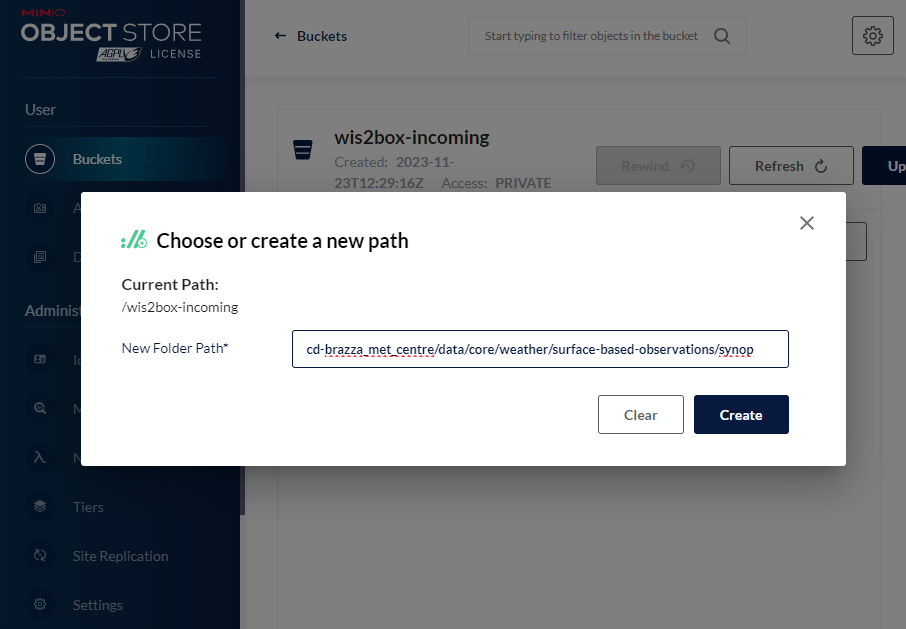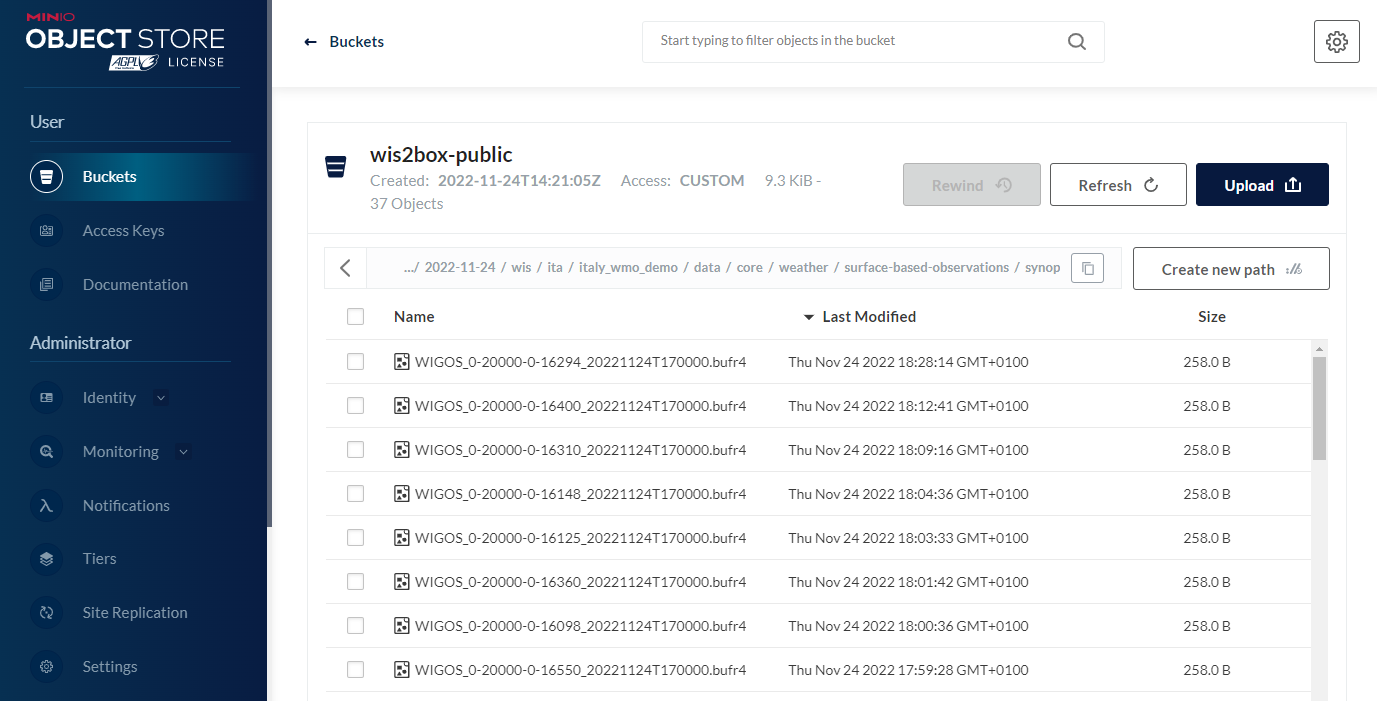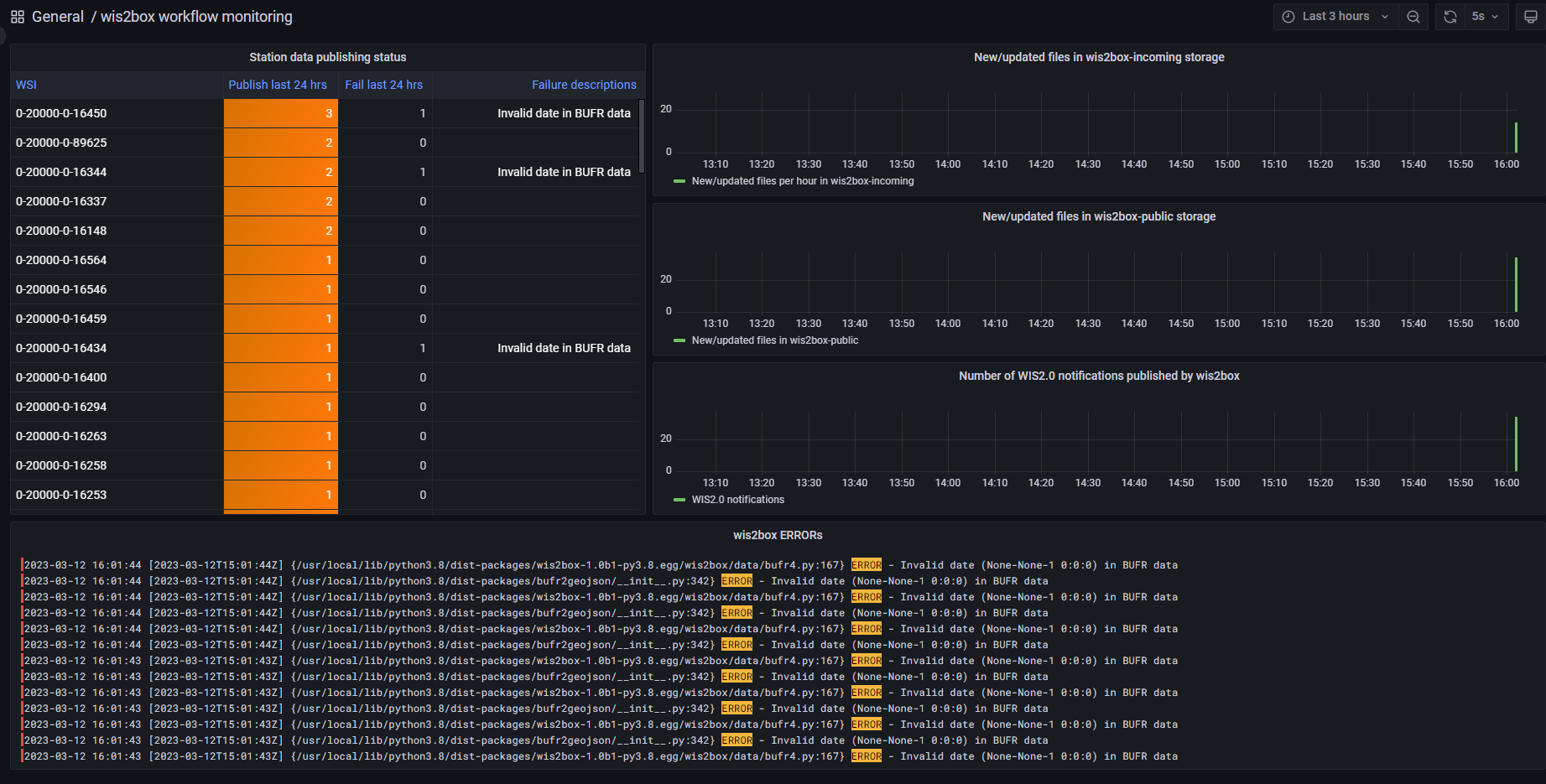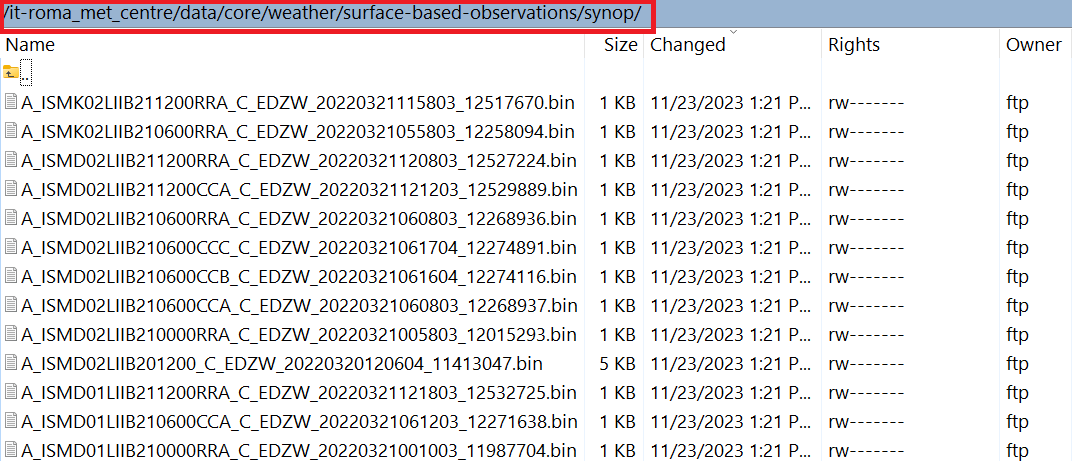Data ingest setup¶
The runtime component of wis2box is data ingestion. This is an event driven workflow driven by S3 notifications from uploading data to wis2box storage.
The wis2box storage is provided using a MinIO container that provides S3-compatible object storage.
Any file received in the wis2box-incoming storage bucket will trigger an action to process the file.
What action to take is determined by the data mappings that were setup in the previous section.
wis2box-webapp¶
The wis2box-webapp is a web application that includes the following forms for data validation and ingestion:
user interface to ingest SYNOP data
user interface to ingest CSV data
The wis2box-webapp is available on your host at http://<your-public-ip>/wis2box-webapp.
Interactive data ingestion requires an execution token, which can be generated using the wis2box auth add-token command inside the wis2box-management container:
python3 wis2box-ctl.py login
wis2box auth add-token --path processes/wis2box
Note
Be sure to record the token value, as it will not be shown again. If you lose the token, you can generate a new one.
MinIO user interface¶
To access the MinIO user interface, visit http://<your-host-ip>:9001 in your web browser.
You can login with your WIS2BOX_STORAGE_USERNAME and WIS2BOX_STORAGE_PASSWORD:

Note
The WIS2BOX_STORAGE_USERNAME and WIS2BOX_STORAGE_PASSWORD are defined in the wis2box.env file.
To test the data ingest, add a sample file for your observations in the wis2box-incoming storage bucket.
Select ‘browse’ on the wis2box-incoming bucket and select ‘Choose or create a new path’ to define a new folder path:

Note
The folder in which the file is placed defines the topic you want to share the data on and should match the datasets defined in your data mappings.
The first 3 levels of the WIS2 topic hierarchy origin/a/wis2 are automatically included by wis2box when publishing data notification messages.
For example:
data to be published on:
origin/a/wis2/cd-brazza_met_centre/data/core/weather/surface-based-observations/synopupload data in the path:
cd-brazza_met_centre/data/core/weather/surface-based-observations/synop
The error message Topic Hierarchy validation error: No plugins for minio:9000/wis2box-incoming/... in data mappings indicates you stored a file in a folder for which no matching dataset was defined in the data mappings.
After uploading a file to wis2box-incoming storage bucket, you can browse the content in the wis2box-public bucket. If the data ingest was successful, new data will appear as follows:

If no data appears in the wis2box-public storage bucket, you can inspect the logs from the command line:
python3 wis2box-ctl.py logs wis2box
Or by visiting the local Grafana instance running at http://<your-host-ip>:3000
wis2box workflow monitoring¶
The Grafana homepage shows an overview with the number of files received, new files produced and WIS2 notifications published.
The Station data publishing status panel (on the left side) shows an overview of notifications and failures per configured station.
The wis2box ERRORs panel (on the bottom) prints all ERROR messages reported by the wis2box-management container.

Once you have verified that the data ingest is working correctly you can prepare an automated workflow to send your data into wis2box.
Automating data ingestion¶
See below a Python example to upload data using the MinIO package:
import glob
import sys
from minio import Minio
filepath = '/home/wis2box-user/local-data/mydata.bin'
minio_path = '/it-roma_met_centre/data/core/weather/surface-based-observations/synop/'
endpoint = 'http://localhost:9000'
WIS2BOX_STORAGE_USERNAME = 'wis2box'
WIS2BOX_STORAGE_PASSWORD = '<your-wis2box-storage-password>'
client = Minio(
endpoint=endpoint,
access_key=WIS2BOX_STORAGE_USERNAME,
secret_key=WIS2BOX_STORAGE_PASSWORD,
secure=is_secure=False)
filename = filepath.split('/')[-1]
client.fput_object('wis2box-incoming', minio_path+filename, filepath)
Note
In the example the file mydata.bin in ingested from the directory /home/wis2box-user/local-data/ on the host running wis2box.
If you are running the script on the same host as wis2box, you can use the endpoint http://localhost:9000 as in the example.
Otherwise, replace localhost with the IP address of the host running wis2box.
wis2box-ftp¶
You can add an additional service to allow your data to be accessible over FTP.
To use the docker-compose.wis2box-ftp.yml template included in wis2box, create a new file called ftp.env using any text editor, and add the following content:
MYHOSTNAME=hostname.domain.tld
FTP_USER=wis2box
FTP_PASS=wis2box123
FTP_HOST=${MYHOSTNAME}
WIS2BOX_STORAGE_ENDPOINT=http://${MYHOSTNAME}:9000
WIS2BOX_STORAGE_USERNAME=wis2box
WIS2BOX_STORAGE_PASSWORD=XXXXXXXX
LOGGING_LEVEL=INFO
ensure MYHOSTNAME is set to your hostname (fully qualified domain name) and WIS2BOX_STORAGE_PASSWORD is set to your MinIO password.
Then start the wis2box-ftp service with the following command:
docker compose -f docker-compose.wis2box-ftp.yml --env-file ftp.env up -d
When using the wis2box-ftp service to ingest data, please note that the topic is determined by the directory structure in which the data arrives.
For example, to correctly ingest data on the topic it-roma_met_centre.data.core.weather.surface-based-observations.synop you need to copy the data into the directory /it-roma_met_centre/data/core/weather/surface-based-observations/synop on the FTP server:

See the GitHub repository wis2box-ftp for more information on this service.
wis2box-data-subscriber¶
Note
This service currently only works with Campbell scientific data loggers version CR1000X.
You can add an additional service on the host running your wis2box instance to allow data to be received over MQTT.
This service subscribes to the topic data-incoming/# on the wis2box broker and parses the content of received messages and publishes the result in the wis2box-incoming bucket.
To start the wis2box-data-subscriber, add the following additional variables to wis2box.env:
CENTRE_ID=zm-zmb_met_centre # set centre_id for wis2-topic-hierarchy
These variables determine the destination path in the wis2box-incoming bucket:
{CENTRE_ID}/data/core/weather/surface-based-observations/synop/
You then you can activate the optional ‘wis2box-data-subscriber’ service as follows:
docker compose -f docker-compose.data-subscriber.yml --env-file wis2box.env up -d
See the GitHub wis2box-data-subscriber repository for more information on this service.
Next steps¶
After you have successfully setup your data ingest process into the wis2box, you are ready to share your data with the global WIS2 network by enabling external access to your public services.
Next: Public services setup